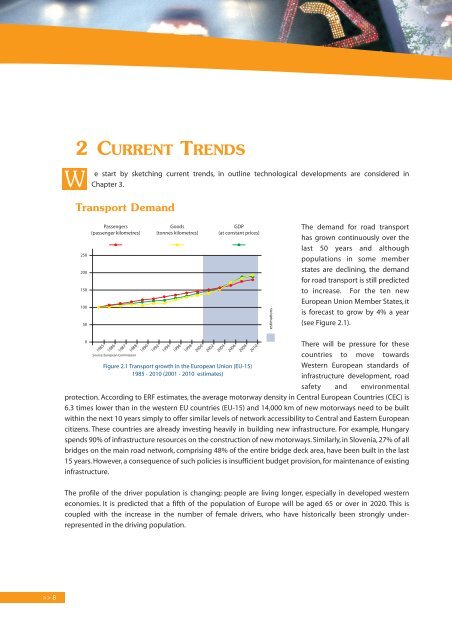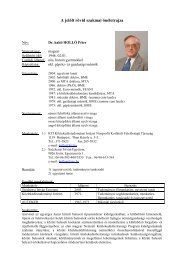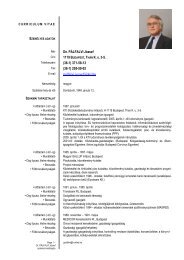VISION: Road Transport in Europe 2025 - FEHRL
VISION: Road Transport in Europe 2025 - FEHRL
VISION: Road Transport in Europe 2025 - FEHRL
You also want an ePaper? Increase the reach of your titles
YUMPU automatically turns print PDFs into web optimized ePapers that Google loves.
8<br />
W e<br />
2CURRENT TRENDS<br />
start by sketch<strong>in</strong>g current trends, <strong>in</strong> outl<strong>in</strong>e technological developments are considered <strong>in</strong><br />
Chapter 3.<br />
<strong>Transport</strong> Demand<br />
250<br />
200<br />
150<br />
100<br />
50<br />
0<br />
Passengers<br />
(passenger kilometres)<br />
Source: <strong>Europe</strong>an Commission<br />
Goods<br />
(tonnes kilometres)<br />
GDP<br />
(at constant prices)<br />
1985<br />
1986<br />
1987<br />
1988<br />
1990<br />
1992<br />
1994<br />
1996<br />
1998<br />
2000<br />
2002<br />
2004<br />
2006<br />
2008<br />
2010<br />
Figure 2.1 <strong>Transport</strong> growth <strong>in</strong> the <strong>Europe</strong>an Union (EU-15)<br />
1985 - 2010 (2001 - 2010 estimates)<br />
The demand for road transport<br />
has grown cont<strong>in</strong>uously over the<br />
last 50 years and although<br />
populations <strong>in</strong> some member<br />
states are decl<strong>in</strong><strong>in</strong>g, the demand<br />
for road transport is still predicted<br />
to <strong>in</strong>crease. For the ten new<br />
<strong>Europe</strong>an Union Member States, it<br />
is forecast to grow by 4% a year<br />
(see Figure 2.1).<br />
There will be pressure for these<br />
countries to move towards<br />
Western <strong>Europe</strong>an standards of<br />
<strong>in</strong>frastructure development, road<br />
safety and environmental<br />
protection. Accord<strong>in</strong>g to ERF estimates, the average motorway density <strong>in</strong> Central <strong>Europe</strong>an Countries (CEC) is<br />
6.3 times lower than <strong>in</strong> the western EU countries (EU-15) and 14,000 km of new motorways need to be built<br />
with<strong>in</strong> the next 10 years simply to offer similar levels of network accessibility to Central and Eastern <strong>Europe</strong>an<br />
citizens. These countries are already <strong>in</strong>vest<strong>in</strong>g heavily <strong>in</strong> build<strong>in</strong>g new <strong>in</strong>frastructure. For example, Hungary<br />
spends 90% of <strong>in</strong>frastructure resources on the construction of new motorways. Similarly, <strong>in</strong> Slovenia, 27% of all<br />
bridges on the ma<strong>in</strong> road network, compris<strong>in</strong>g 48% of the entire bridge deck area, have been built <strong>in</strong> the last<br />
15 years. However, a consequence of such policies is <strong>in</strong>sufficient budget provision, for ma<strong>in</strong>tenance of exist<strong>in</strong>g<br />
<strong>in</strong>frastructure.<br />
The profile of the driver population is chang<strong>in</strong>g; people are liv<strong>in</strong>g longer, especially <strong>in</strong> developed western<br />
economies. It is predicted that a fifth of the population of <strong>Europe</strong> will be aged 65 or over <strong>in</strong> 2020. This is<br />
coupled with the <strong>in</strong>crease <strong>in</strong> the number of female drivers, who have historically been strongly underrepresented<br />
<strong>in</strong> the driv<strong>in</strong>g population.<br />
estimations






